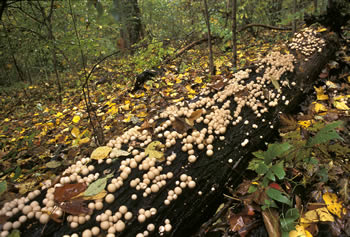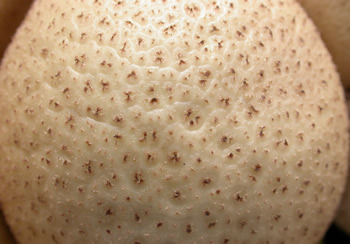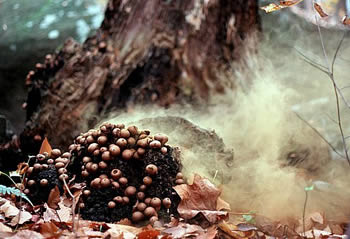 |
| Fig. 1 A stump colonized by the pear-shaped puffball fungus (Emberger, 2008). |
Name: Lycoperdon pyriforme -Pear-Shaped Puffball
Family: Lycoperdaceae
Collection Date: October 4, 2011
Habitat: Growing in clusters on decaying wood
Location: Hiram, Ohio
Description: "The fruiting body is pear-shaped to nearly round, but usually with a stemlike sterile base; 1.5-5 cm high and sometimes almost as broad as broad in the widest part. Peridium (skin) whitish to pale brown when young, yellowish to dark rusty-brown in age; at first smooth or with a few small scattered spines on top, then becoming finely cracked to form small patches or minute granules or particles (making it rough to the touch), this rough outer layer slowly but eventually falling away to expose the smooth inner layer in which an apical pore or tear is very slow to form. The sterile base is small or well-developed, spongy when fresh, occupying the stemlike base (if base present); chambers very small; conspicuous white mycelial threads (rhizomorphs) usually radiating from the base and connected to others in the surrounding wood or humus. The spore mass at first is firm and white, then yellow to olive and finally deep olive-brown and powdery. They tend to be scattered to densely gregarious or clustered on stumps, rotting logs, sawdust, and in lignin-rich humus; widely distributed and common, fruiting mostly in the fall and winter, but old bleached-out fruiting bodies can be found anytime. It is edible when young" (Arora p. 691-692, 1986).
Collector: Brooke Warren
Keys used: Arora, D. (1986). Mushrooms Demystified. New York: Ten Speed Press.
Keying steps:
Key to the Major Groups of Fleshy Fungi
1A. Spores produced on mother cells called basidia; fruiting body variously shaped (see pp. 52-54)... Basidiomycotina, p. 57
Key to the Basidiomycetes1B. Basidia and spores borne internally (inside the fruiting body or inside a spore case or small capsules); spores not forcibly discharged, thus a spore print unobtainable Gasteromycetes, p. 676
Key to the Gasteromycetes
1B. Fruiting body differently constructed and usually larger than above... 2
2B. Not as above (but fruting body may be slimy or malodorous at some stage)... 3
3B. Stalk absent or rudimentary... 7
7A. spore case rupturing or disinteggrating at maturity; spore mass firm and solid when young (chambers present hardly discernible), powdery or cottony when mature and usually dispersing fairly soon; columella (internal stalk) typically absent; mature fruiting body usually (but not always) above ground; found in many habitats... Lycoperdales & Allies, p.677
Key to the Gasteromycetes
1B. Fruiting body differently constructed and usually larger than above... 2
2B. Not as above (but fruting body may be slimy or malodorous at some stage)... 3
3B. Stalk absent or rudimentary... 7
7A. spore case rupturing or disinteggrating at maturity; spore mass firm and solid when young (chambers present hardly discernible), powdery or cottony when mature and usually dispersing fairly soon; columella (internal stalk) typically absent; mature fruiting body usually (but not always) above ground; found in many habitats... Lycoperdales & Allies, p.677
Key to the Lycoperdales & Allies1B. Not as above (fruiting body may rupture in starlike fashion, but if so then there is no separate spore case within)... 2
2B. Spore mass not containing peridioles, or if so then the peridioles considerably larger than grains of sand (usually aappearing more like seeds)... 4
4B. Not as above; peridioles absent; spores produced in a single large chamber (the spore case)... 5
5B. Not as above; skin (peridium) thick or thin; spore mass white when young and normally softening or becoming mushy as it darkens, then becoming powdery; basidia usually borne in a hymenium; capillitium usually present... 6
2B. Spore mass not containing peridioles, or if so then the peridioles considerably larger than grains of sand (usually aappearing more like seeds)... 4
4B. Not as above; peridioles absent; spores produced in a single large chamber (the spore case)... 5
5B. Not as above; skin (peridium) thick or thin; spore mass white when young and normally softening or becoming mushy as it darkens, then becoming powdery; basidia usually borne in a hymenium; capillitium usually present... 6
6B. Not as above... 7
7B. Not as above... 8
8A. Sterile base present, often as a narrowed stemlike base beneath the spore case (section fruiting body lengthwise if unsure)... 9
9B. Fruiting body small to medium-sized (usually smaller than a baseball), typically rupturing through an apical pore, slit, or large mouth; usually thin-skinned... Lycoperdon & Allies, p. 690
Key to Lycoperdon & Allies
1B. Not as above; fruiting body not dark brown when young (but may be pale to medium brown when young and become dark brown in old age)... 2
2A. Growing on wood, sawdust, or lignin-rich humus (if in humus, then base with white mycelial threads or rhizomorphs and spore case with inconspicuous spines if any)... 3
3B. Not as above; fruiting body never pitted, usually with white mycelial threads (rhizomorphs) at base or in surrounding substrate; sterile base well-developed; common and widespread... L. pyriforme &others, p. 691
 |
| Fig. 2 This image sowhs the warts on the puffballs peridium (Emberger, 2008). |
 |
| Fig. 3 Spore cloud (Emberger, 2008). |
Additional References:
Emberger, G. (2008). Lycoperdon Pyriforme. Messiah College.
http://www.messiah.edu/Oakes/fungi_on_wood/puffball%20and%20cushion/species%20pages/Lycoperdon%20pyriforme.htm
http://www.messiah.edu/Oakes/fungi_on_wood/puffball%20and%20cushion/species%20pages/Lycoperdon%20pyriforme.htm
Links:
No comments:
Post a Comment